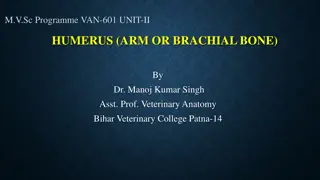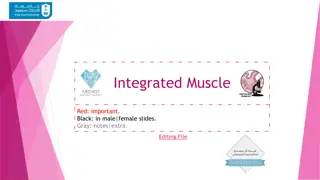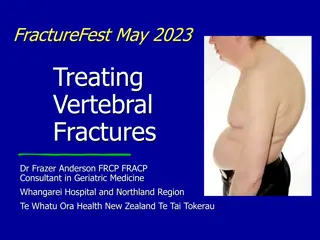Understanding Muscle, Bone, and Joint Injuries: Care and Treatment
Explore musculoskeletal injuries, head and back injury signals, and proper care techniques. Learn about ligaments, sprains, strains, fractures, dislocations, and RICE treatment for strains and sprains. Discover why RICE method is beneficial and methods for splinting fractures and dislocations.
Download Presentation

Please find below an Image/Link to download the presentation.
The content on the website is provided AS IS for your information and personal use only. It may not be sold, licensed, or shared on other websites without obtaining consent from the author. Download presentation by click this link. If you encounter any issues during the download, it is possible that the publisher has removed the file from their server.
E N D
Presentation Transcript
Muscle, Bone and Joint Injuries
MUSCLE, BONE AND JOINT INJURIES Have you ever suffered a fracture or dislocation? What was the mechanism of injury? (How did the injury happen?) How was it cared for?
Students will be able to: Identify various musculoskeletal injuries. Identify signals of head, neck and back injuries. Demonstrate how to care for head, neck and back injuries. Demonstrate how to care for musculoskeletal injuries.
Sprain stretch or tear of a ligament What does a ligament connect? Terminology
Strain stretch or tear of a muscle or tendon Terminology
RICE Rest Ice Compression Elevation Treatment for Strains & Sprains
Why Rice? REST - Avoids further damage - Length of rest varies Compression -Helps control swelling -Provides Support Elevation -limits swelling - Encourages venous return ICE -Slows down swelling - Decreases local blood flow - Decreases pain
Fracture break or disruption of bone Terminology
Dislocation Disruption of joint where it becomes Out of place Terminology
Splint a method of immobilizing an injury Treatment for Fractures & Dislocations
Splinting Methods Soft Splinting Use soft materials Blanket, towel, pillow, jacket, etc
Splinting Methods Rigid Splinting Use hard materials Boards, magazines, newspaper, cardboard, tree limbs, etc
Splinting Methods Anatomical Splinting Use victim s body or body part Arm to chest Leg to leg
Splinting Methods Sling & Swath Use triangular bandages Use on upper extremity Sling on injured arm Swath across chest
Cravat triangular bandage used to make a sling
Care for Muscle, Bone & Joint Injuries Check for signs of circulation (feeling warmth and color) after splint is applied Splint should be snug but not cut off circulation Splint body part in position you find it Immobilize body parts above and below injury site
Check for Pulse Feeling Warmth of skin Color of skin Capillary refill Signs of Circulation
Sign Any observable evidence of an injury Deformity Bruising or swelling Inability to use the affected part normally Bilateral Comparison Mechanism of injury Determining the Severity
Determining the Severity Symptom What the victim tells you about his or her condition Feels bone grating Heard or felt a pop or snap at time of injury Pain Scale (1-10) Numbness or tingling in extremity
What causes Head, Neck & Back Injuries? Motor vehicle accidents Landing head first (diving into shallow pool) Bike or motorcycle accidents (with or without helmets) Lifting objects Falls, slips Fall from a height Acts of violence Direct blow Sports Injuries Twisting mechanism
S & S of Head, Neck & Back Injuries Change in consciousness Numbness or tingling into hands or feet Loss of movement in arms or legs Breathing difficulty Vision problems Headache Loss of balance Blood from nose or ears or bleeding from head, neck or back Unusual bumps or depressions on head, neck or back Mechanism of injury leads you to believe there is head, neck or back injury Neck or back pain
Call 911 Minimize movement of victim (keep victim from moving by using your hands) Monitor ABCs Keep victim from becoming chilled or overheated Be prepared to use lifesaving skills Care for Head, Neck & Back Injuries
Minimize movement of victim Place hands on both sides of head Hold persons head in line with spine Support in position you found it Methods in care for HNB injuries
Minor-RICE: Rest, Ice Compression & Elevation Severe- H-N-B Injury Splint if: You are not using EMS to move victim You can do it without causing more pain Minor vs. Severe Care
Videos Sling & Swath - 3:22 - http://www.youtube.com/watch?v=49VBb HaXr8A SAM splint - ankle - 2:41 - http://www.youtube.com/watch?v=pQj5x COukZo&feature=related Arm/wrist - 3:15 - http://www.youtube.com/watch?v=Ot7c3 syPtr4&feature=related
Lets start Splinting! Use Triangular Bandages Sam Splint on ankle Magazine on wrist Sling & Swath























